This is a complete guide to Japan's "maneki neko" or "lucky cat," long considered to grant people luck. To this day, maneki neko remain popular and are sold as decorative items or given as a gift when a new shop is opened. This article will cover a variety of topics, including the history of maneki neko, the benefits that they are said to invite, the proper way to arrange them, recommended maneki neko to purchase, and other interesting tidbits!
*Note, if you're looking to buy a maneki neko, you can click here to view the BECOCS Lucky Cat Collection
What Is a Maneki Neko?

In Japan, maneki neko are universally known as decorative figurines used to invite business prosperity. The key characteristic of the maneki neko is its paw, raised in a pose seeming to beckon to people. Some raise their right paw, others raise their left paw, and even others still raise both paws into the air.
What Does Maneki Neko Mean?
In Japanese, "maneki" means "beckoning" or "inviting," and "neko" means "cat." Thus "maneki neko" translates to "beckoning cat," which is quite literally what they are.
Maneki Neko - Japan's Lucky Cats
As cats hunt the rats and mice that eat agricultural produce and silkworms, they were originally considered lucky charms for silk production. However, as silk production decreased over time, they became loved as a lucky charm for business prosperity, instead.
Recently, the cuteness of maneki neko has driven up their popularity and they are now frequently placed as decoration in people's houses or given as gifts to celebrate the construction of a new building or opening of a new shop or business.
The Origin of Maneki Neko

Cats have been valued since ancient times for their valuable role in protecting grain from rats and other rodents. Since the construction of old buildings wasn't as sound as it is today, rats could easily enter and ruin one's hard-earned stock of harvested crops. Households that invited cats inside to live with them were able to preserve their harvests, thus making them more prosperous. From then on, cats began to be considered as animals that invited good fortune.
However, back during the Edo Period (1603 - 1680), as there weren't that many cats around, only a portion of people were able to keep cats. They remained out of reach of most commoners. In response, some began to hang pictures of cats inside their stores instead, which is said to be the origin of the maneki neko.
Besides this story, many other theories about the origin of the maneki neko exist, including one that claims Gotokuji Temple in Tokyo's Setagaya Ward as the birthplace, or another that says it started at Jishoin Temple in Shinjuku. There are also some who say that the model for the maneki neko was likely intended to represent self-grooming.
Understand the Various Meanings Behind the Maneki Neko
Does the Raised Paw Have Meaning?

Maneki neko can be found in many variations, raising their left, right, or both paws. Whether the left or right paw is raised is no mistake, as each is said to represent the beckoning of a different type of luck.
● Maneki Neko Raising Their Right Paw
Believed to primarily beckon money or financial good fortune. Most maneki neko found placed in typical houses have their right paw raised like this.
● Maneki Neko Raising Their Left Paw
Primarily believed to beckon people. As the beckoning of customers naturally leads to business prosperity, many people choose to buy a maneki neko raising its left hand.
● Maneki Neko Raising Both Paws
Although some say that it invites both money and people, raising both hands in a "banzai" pose ("banzai" is a customary word shouted by a crowd as everyone raises both hands in celebration) is also sometimes said to be unlucky, as the word "banzai" can also mean bankruptcy or surrender, so be careful before choosing this type of figure.
Additionally, the higher that the paws are raised, the greater or further away the luck being invited is said to be.
What Is the Golden Thing That the Maneki Neko Is Holding?

Many reading this article have likely looked closely at a maneki neko and wondered what the item being held under its arm is (the thin gold oval-shaped thing in the photo above). This is a gold coin called a "koban" that was used long ago. Most maneki neko you see will have this. It is said that this type of maneki neko first started being made around 1950.
Maneki neko made before that time didn't have a koban coin. Instead, most simply featured a bell around their neck. Over time, the bell shifted to a coin instead. Another shift that took place over time was in the words written on the coin. At first, most coins had the value 千両 (1,000 ryo) written on them (ryo was an old Japanese denomination). However, as time passed, the value of coins started to grow, with some showing 10,000 ryo (千万両), 1,000,000 ryo (千百万両), and even the absurd amount of 100,000,000 ryo (億万両)!
Thanks to this, it's possible to gauge the period in which a certain maneki neko was made just by looking at the amount written on the koban coin. This is something handy to remember when trying to determine if a piece is really an antique or not.
Differently-Colored Maneki Neko Invite Different Kinds of Luck

Maneki neko come in a wide variety of colors such as red or yellow, and the type of luck that they are said to invite varies based on the color.
Lucky White - The Most Popular Color
White is the most popular color and believed to generally invite luck of all kinds.
Black - For Family Peace and Prosperity
Black cats are often thought of as unlucky, but in Japan, they have long been said to ward off evil spirits and protect peace and prosperity in the home.
Gold or Yellow - Financial Good Fortune
Gold or yellow maneki neko are said to bring financial good fortune and wealth, and it's true that seeing a golden one does invoke the image of riches.
Red - Good Health
Red maneki neko invite the benefits of good health and longevity. Red was first used back when smallpox was fatal. The disease was believed to be the work of a smallpox demon, who was thought to despise the color red.
Pink - Love Fulfillment
Pink maneki neko are said to invite fulfillment of love wishes. As maneki neko with their left paw raised are said to invite people, we recommend choosing a pink maneki neko that has its left paw raised if you want your wish for love to be fulfilled.
Interesting Facts About Maneki Neko
Where in the House Should I Place a Maneki Neko?

In order to invite the most good fortune, the standard location to place a maneki neko within the house is at the front entrance. The reason for this is that the most logical place for people or monetary luck to enter a house is through the front door. As for its orientation, make sure that it is angled with its front to the door.
As an extra boost to its effectiveness, placing a maneki neko in a spot higher than the height of people is said to be good. On the other hand, be sure to avoid placing it in a closet or other place within the house where people do not come and go, as maneki neko don't like these kinds of places.
Related Article: ▶ 25 Japanese Feng Shui Items for Your Front Door
How Should I Care For a Maneki Neko?
It depends on the materials that the maneki neko is made out of, but generally making sure that too much dust doesn't collect on it is the standard care that it needs. Clean the grime off of ceramic maneki neko by gently wiping it with a soft cloth. For ones made of wood or cloth, be careful not to get them wet as mold can start to grow.
Otherwise, be sure to pet it every now and then, just as you would with a real cat!
Did You Know That There Is a Maneki Neko Day in Japan?
In Japan, September 29th is designated as "Maneki Neko no Hi," a day to celebrate maneki neko. The day was designated in 1995 by a group of maneki neko lovers called the "The Association for Maneki Neko Japan."
The reason that September 29th was chosen is due to a play on words. In Japanese, 9 can be read as "ku" and 2 can be read as "fu," so 9/29 represents the phrase 来る福 ("kuru fuku"), meaning "come, good fortune." Each year on this day in Japan, maneki neko-related events are held throughout the country.
Among these events, some that stand out as being comparatively large are one in Seto City, Aichi Prefecture—located partway between Tokyo and Osaka—and the "Kurufuku Maneki Neko Festival, held in Ise City in Mie Prefecture, which is southwest of Aichi Prefecture (event links below). This festival has now been held more than 20 times and receives the support of many people.
・Aichi Prefecture "KURUFUKU Maneki Neko Festival in Seto" official site: http://www.seto-marutto.info/event-post/manekinekofestival/ (Japanese Only)
*The 2020 event was canceled, but the event is typically held on the weekend closest to September 29th. The 2021 event is yet to be confirmed.
・Mie Prefecture "Kurufuku Maneki Neko Festival" official site: https://www.kankomie.or.jp/event/detail_41105.html (Japanese Only)
*The 2021 event is yet to be confirmed.
The Proper Way to Dispose of a Maneki Neko
The proper ways to dispose of a maneki neko are either to take it to a shrine or temple in Japan for ceremonial disposal or to have it collected as trash in a bag together with coarse salt.
If you are able to bring it with you to Japan to have it burned in a disposal ceremony at a shrine or temple, this is the ideal way to do it, as lucky items and talismans such as maneki neko are said to be easy places for energy or spirits to enter and stay.
Otherwise, placing it in a garbage bag along with purification salt (in Japan, salt itself is considered to have powers of purification, so regular salt is also OK) and putting it out along with your other garbage for collection is also fine. As long as you do it with a feeling of gratitude, new good fortune will be sure to follow. However, throwing it away in a careless or violent manner is said to be extremely unlucky, so be careful when disposing of a maneki neko.
Japan's Two Maneki Neko Hotspots
There are two spots in Japan that are considered to be the holy grounds of maneki neko, both of which can be found in Tokyo.
Imado Shrine (Asakusa)
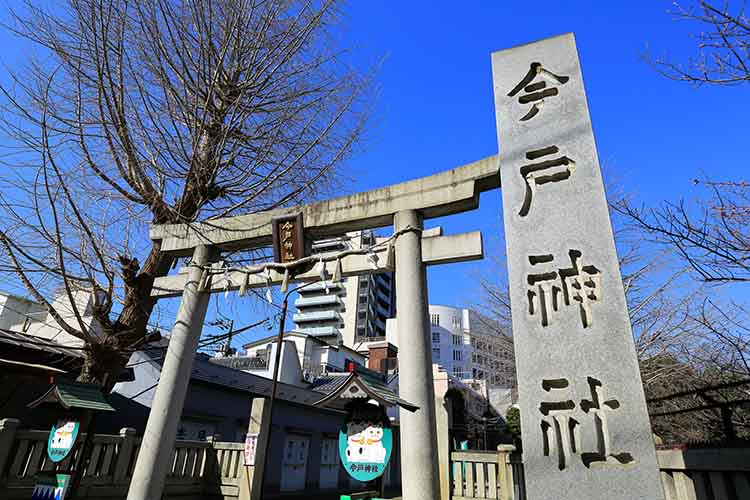
The first place is a shrine called Imado Jinja that can be found in Asakusa, one of Tokyo's premier sightseeing locations. It's difficult to make out, but a sign in the photo above says "招き猫発祥の地" ("birthplace of the maneki neko").
There's a story about an old woman living in the neighborhood towards the end of the Edo Period (around 1860) who, facing poverty, was forced to let go of her beloved pet cat. The story goes that her cat appeared in her dream and told her that she could make money if she were to create a doll in the figure of the cat, and the Imado Ware (a local type of ceramic) cat figurines that she made thereafter became famous.

Also, Imado Shrine is said to bestow blessings of matchmaking, and is known for a pair of male and female maneki neko statues.
Name: Imado Shrine
Opening Hours: Open year-round, 24 hours (shrine office hours can be found on the official website)
Address: 1-5-22, Imado, Taito-ku, Tokyo
東京都台東区今戸1-5-22
Google Maps
Official Website: https://imadojinja1063.crayonsite.net/ (Japanese Only)
Gotokuji Temple (Setagaya)

Another hotspot in Tokyo is Gotokuji Temple, located in Setagaya Ward, which is to the southwest of Shibuya. At Gotokuji, maneki neko figurines of all sizes can be purchased and wished upon. People normally offer them to the shrine and place them in a designated part of the shrine dedicated to maneki neko, where hundreds upon hundreds of the figurines can be found. That said, some people choose to take their maneki neko home with them and later bring it back to offer it once their wish has been fulfilled.
Name: Gotokuji Temple
Opening Hours: 6:00 am - 6:00 pm (*Shrine office desk hours: 9:00 am - 4:30 pm)
Address: 2,-24-7, Gotokuji, Setagaya-ku, Tokyo
東京都世田谷区豪徳寺2-24-7
Google Maps
Setagaya Ward official site (info for Gotokuji): https://www.city.setagaya.lg.jp/theme/kanko/002/003/002/d00006127.html (Japanese Only)
Related article: ▶ Daruma Dolls: Which Eye to Paint First? How to Properly Dispose of Them Abroad?
Great Maneki Neko to Give as a Gift or to Decorate Your House With
Apart from various colors, maneki neko also come in a wide range of shapes and sizes. They're famous as lucky charms, but can also just be used for decoration, so they make for great gifts that have the added benefit of bringing good fortune to whomever you give it to. As maneki neko are important lucky items that you'll be placing in your home, we will only introduce carefully chosen, quality items made in Japan by traditional Japanese craftspeople with proven skills.
Featured Products
1. White Edo Kimekomi Maneki Neko, Right Paw Raised for Money
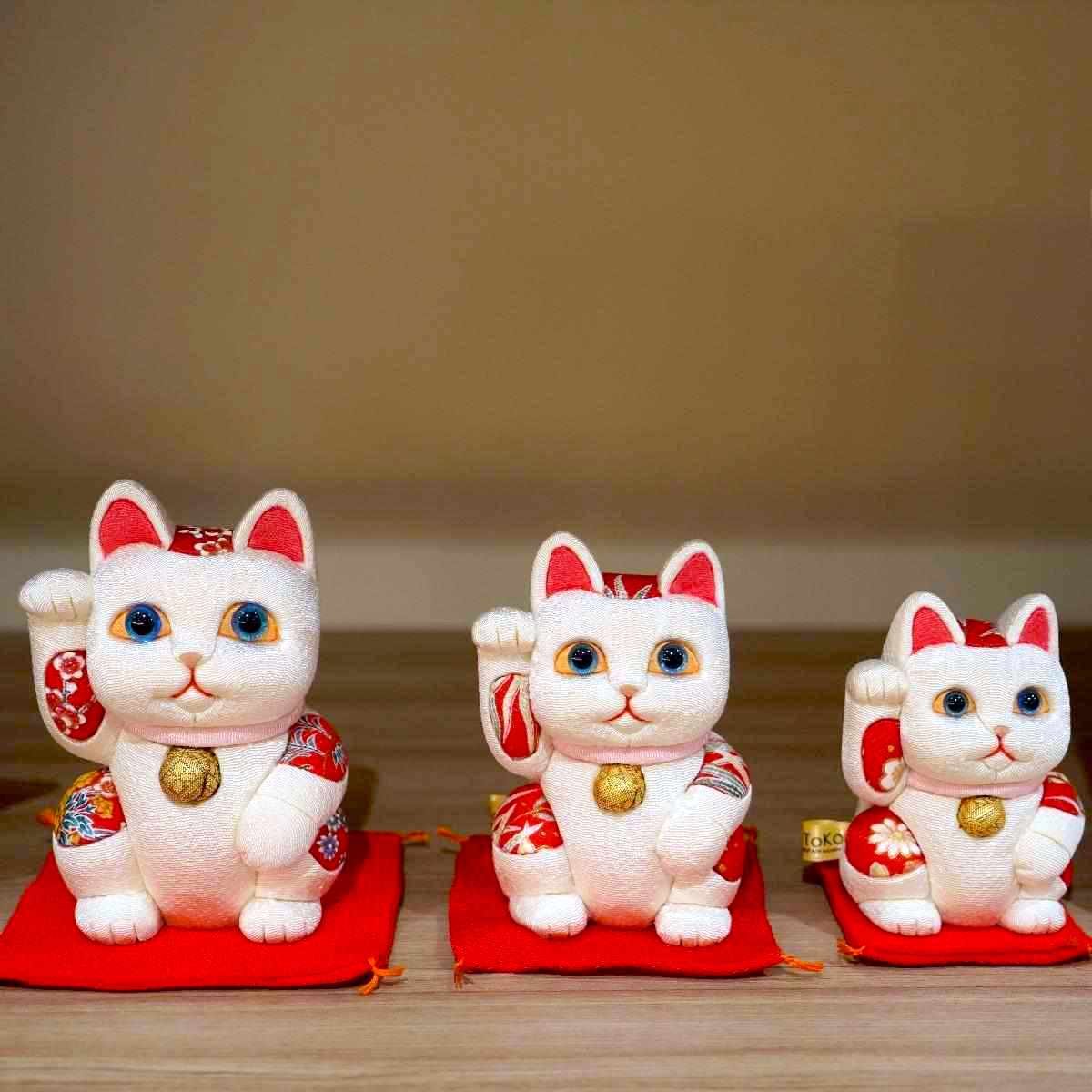
The most popular maneki neko item on BECOS is this adorable lucky cat made by Kakinuma, a workshop specializing in the traditional Edo Kimekomi technique. This technique involves carving a base from "toso," a material made from sawdust and resin and carefully attaching pieces of fabric on the outside to create dolls filled with character and life. This white maneki neko comes in 3 sizes (S, M, L) and is very affordable, especially considering the time it takes to hand make each one.
2. Hello Kitty Edo Kimekomi Maneki Neko
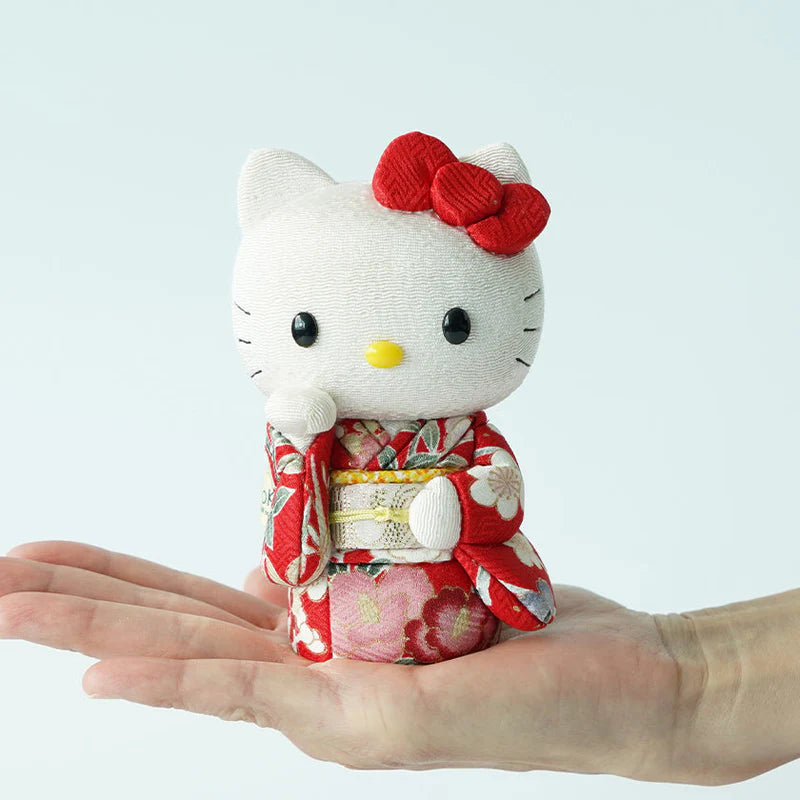
This adorable maneki neko fits in the palm of your hand and is designed to look like Sanrio's iconic character Kitty-chan (Hello Kitty). She's decked out in a beautiful floral kimono and has her right paw raised to beckon wealth into your life. This doll is also made by Kakinuma, the Edo Kimekomi maker introduced above, and the quality of the piece far exceeds its price tag.
3. Hizen Yoshida-ware Maneki Neko
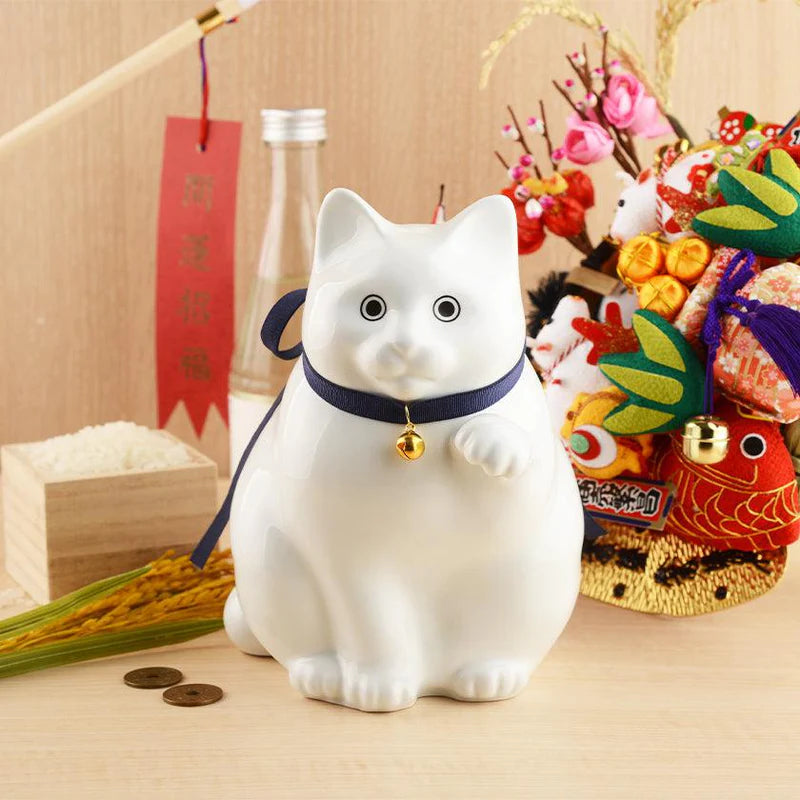
This cute chubby maneki neko is raising its left paw, beckoning people into your life. It is made in the Hizen Yoshida area, a little-known ceramics-producing area in Saga Prefecture. The area historically produced ceramics subcontracted by makers in the more famous ceramics areas of Arita and Hasami, but Katakoto (the maker of this maneki neko) wanted to create original items that the area could be proud of. The maneki neko is not only adorable, but it also features a coin slot in the back of its neck, concealed by the ribbon, which allows it to serve as a piggy bank as well!
4. Slim Hizen Yoshida Maneki Neko Piggy Bank
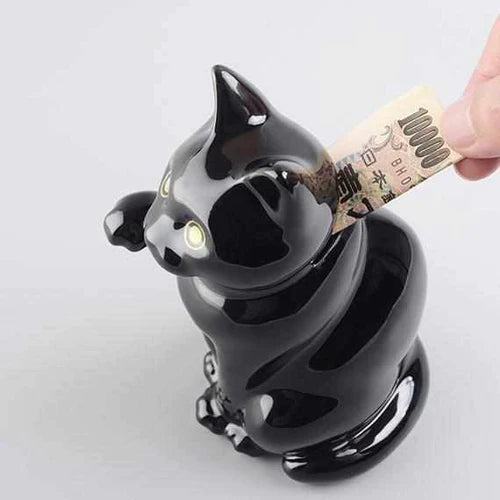
If you prefer daintier cats, this adorable little maneki neko, also made by Katakoto (the maker of the chubby maneki neko above) might be just what you're looking for. It's also made from Hizen Yoshida-ware and features a slot in the back of its neck for coins (or bills) to be inserted for saving. Unlike its chubbier counterpart, this little guy has his right paw raised, beckoning for wealth, so perhaps he will actually end up with more money inside even though there's less room!
5. Large Edo Kimekomi Maneki Neko
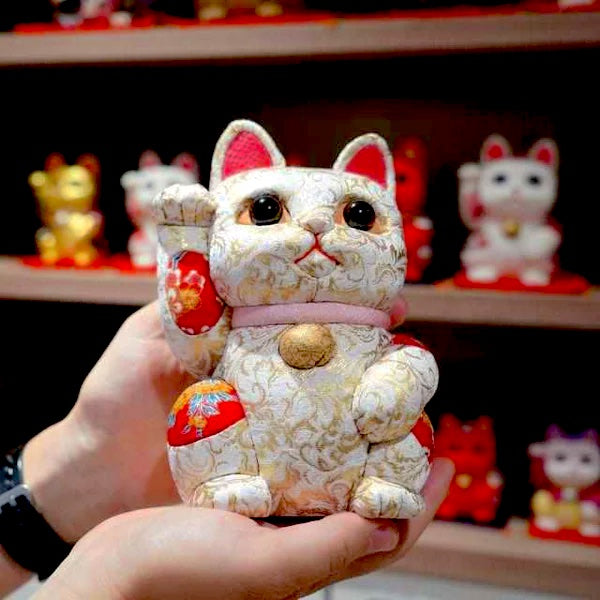
If you're looking for a larger maneki neko with a strong presence (perhaps you want to really invite some major wealth into your life), look no further than this luxurious maneki neko from Kakinuma. It features a base of enamel covered with high-end "Nishijin-ori" (Nishijin brocade) from Kyoto, which is itself designated as a traditional Japanese craft. For the eyes, Swarovski crystal is used, causing them to sparkle as the light hits them at various angles.
▶ Interested in purchasing your own Japanese doll? Check out all the available options here.
Add a Maneki Neko to Your Living Space and Invite Good Fortune Into Your Life!
Maneki neko are believed to be lucky omens that invite various forms of good fortune into one's life. The type of good fortune varies based on the color, so choose one that invites the kind of fortune that you need in your life. There are many different styles, so check them out before you decide which is right for you. Once you find one that you like, set it up at your front entrance and let it bring you lots of good fortune!

The picture above shows another maneki neko made by Kakinuma Dolls, the same workshop that makes the "Edo Kimekomi Ningyo" maneki neko introduced above. Each exquisite piece is carefully handmade, one by one. Those who are interested should check the link below!
▶ Click here to browse more popular Maneki Neko items!
Related articles:
▶ 6 Japanese Lucky Charms: The Allure of the Daruma and Lucky Cat
▶ The Complete Guide to Traditional Japanese Crafts
*These products may not be able to be shipped to certain countries. Please see the retailer's website for more information.
The information in this article is accurate at the time of publication.
